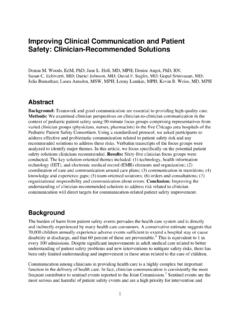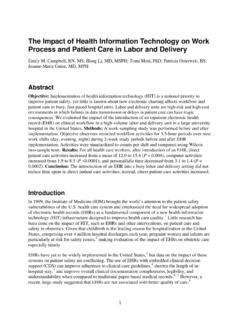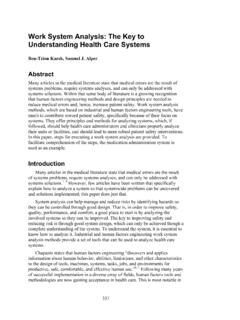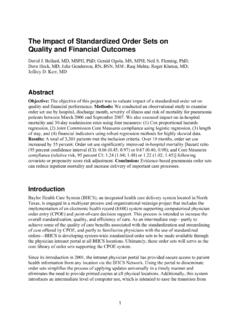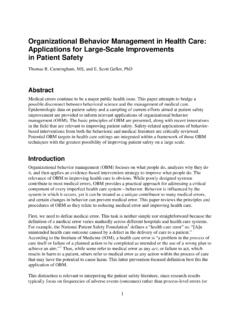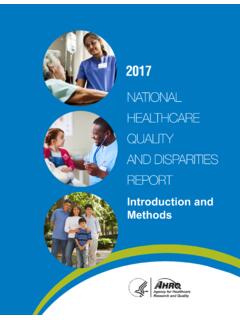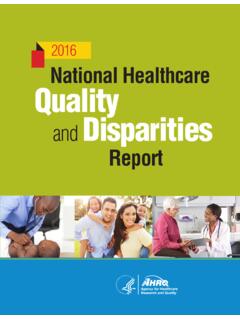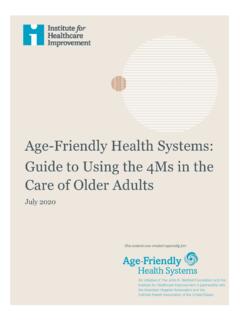Transcription of Systems-Based Practice: Improving the Safety and Quality ...
1 Systems-Based Practice: Improving the Safety and Quality of Patient Care by recognizing and Improving the Systems in Which We Work Julie K. Johnson, MSPH, PhD; Stephen H. Miller, MD, MPH; Sheldon D. Horowitz, MD Abstract As the complexity of health care delivery has increased, it has become essential for physicians to understand how individual practices relate to the larger system of It is within this context that the Accreditation Council for Graduate Medical Education (ACGME) and the American Board of Medical Specialties (ABMS) identified Systems-Based practice (SBP) as one of the six core competencies in which physicians must be proficient to deliver patient care that is safe and high in Quality . SBP is challenging to define, incorporate into training and practice, and evaluate. Competency in SBP requires that physicians understand how patient care relates to the health care system as a whole and how to use the system to improve the Quality and Safety of patient care.
2 Systems thinking is the cornerstone of SBP. Fostering the ability to recognize the contribution of the system is important for medical students, residents, and practicing physicians. However, current efforts in medical education focus on mastering knowledge of disease, diagnostic skills, and treatment at the level of the physician-patient interaction. As a result, there is a preoccupation with system components, while the system as a whole and its effect on the Quality and Safety of care remain invisible. To clarify the definition of SBP and to develop effective strategies for teaching and assessing SBP, it is necessary to provide a broad awareness of systems within a context of systems thinking. Patient Safety is a good entry point into SBP because the concepts of Safety , errors, and harm all place the individual, whether patient or provider, within the framework of a system .
3 Background and Rationale The Accreditation Council for Graduate Medical Education (ACGME) and the American Board of Medical Specialties (ABMS) identified six core competencies required of residents and physicians to deliver high Quality medical care patient care, medical knowledge, practice- based learning and improvement, interpersonal and communication skills, professionalism, and Systems-Based practice. Of these six, Systems-Based practice is one of the most challenging to define, incorporate into training and practice, and evaluate. Systems-Based practice can be thought of as an analytic tool, as well as a way of viewing the world, both of which can make caregiving and change efforts more successful. The focus is on understanding the interdependencies of a system or series of systems and the changes identified 1 to improve care that can be made and measured in the system .
4 The metaphors a village and a mirror have been used to illustrate and differentiate the concepts of Systems-Based practice (SBP) and practice- based learning and improvement (PBLI). SBP is like a village. A physician must work with a community of providers to deliver optimal patient care. 2 This is contrasted with the core competency of PBLI, where the metaphor is a mirror. PBLI is like holding up a mirror to ourselves to document, assess, and improve our practice. 2 In clinical settings, we can operationalize these concepts by asking two separate but related questions: 1. The PBLI question: How can I improve the care for my patients? 2. The SBP question: How can I improve the system of care? Since the landmark Institute of Medicine (IOM) report focused national attention on patient Safety , it has been generally agreed that the systems we work within are at the root of many of our patient Safety Safety is a property of systems.
5 Many of our patient Safety initiatives belong to the system . Furthermore, certain patient Safety issues are especially relevant to system solutions. These include the World Health Organization s list of High 5 patient Safety initiatives managing concentrated injectable medicines, assuring medication accuracy at transitions in care, communicating during patient handovers, Improving hand hygiene to prevent infections associated with health care, and performing correct procedures at correct body sites4 and The Joint Commission s patient Safety goals, which are updated Although an understanding of systems is essential to improve the Quality and Safety of patient care, training in SBP falls outside the scope of traditional training. As result, undergraduate medical institutions, residency programs, specialty boards, and societies may have difficulty effectively teaching and evaluating SBP.
6 In addition, although SBP is required by the ACGME as one of the core competencies that residents must demonstrate, there is a lack of literature about how to integrate the theory of systems and systems thinking into medical education. The common program requirements for SBP, as approved by the ACGME in February 2007,6 are outlined as follows: Residents must demonstrate an awareness of and responsiveness to tlarger context and system of health care, as well as the ability to call effectively on other resources in the system to provide optimal health care. Residents are expected to: he Work effectively in various health care delivery settings and systems relevant to their clinical specialty. Coordinate patient care within the health care system relevant to their clinical specialty. Incorporate considerations of cost awareness and risk-benefit analysis in patient and/or population- based care as appropriate.
7 Advocate for Quality patient care and optimal patient care systems. Work in interprofessional teams to enhance patient Safety and improve patient care Quality . Participate in identifying system errors and implementing potential systems solutions. The aim of this paper is to further refine the definition of SBP by providing a broad awareness of systems within a context of systems thinking and to highlight the importance of teaching SBP as part of any program focused on Improving the Quality and Safety of care. 2 Definition of a system Implementing and evaluating SBP in a medical context requires a broader understanding of what constitutes a system , coupled with an understanding of systems thinking. Bertalanffy, the founder of the scientific, mathematical Theory of Systems, defined a system as a set of interacting, interrelated, or interdependent elements that work together in a particular environment to perform the functions that are required to achieve the system s The importance of understanding systems as interrelated parts of a whole cannot be overstated.
8 Systems can be continually improved, but one must consider how its products are created, why they are created, and how they can be improved. Comprehending the assembly of the system as a whole can inform the work of those who are trying to create successful, interdependent Learning to see interrelationships, rather than linear cause-and-effect chains, and grasping the phenomenon of change as a process, rather than as a snapshot, are essential for understanding Systems have certain rules (or principles) that help us predict how they will behave:10, 11 The whole has one or more defining functions. Each part can affect the behavior or properties of the whole. Each part is necessary but alone is insufficient to carry out the defining function of the whole. Behavior and properties of one part of the system depend on the behavior and properties of at least one other part of the system .
9 Systems thinking is the cornerstone of how learning organizations think about their Learning organizations are those that measure outcomes and strive for improvement. Many fields outside health care including education, telecommunications, and aviation use systems theory to better serve their clients, understand applicable research, improve outcomes, and ensure Quality and Safety . recognizing feedback from the system and using that feedback for design and redesign of services is an inherent element of systems thinking. Competence in SBP necessitates that physicians understand how patient care and other practices relate to the health care system as a whole and how to use the system to improve patient outcomes, Safety , and Quality . SBP is care that is sensitive to the context in which it is delivered. Fostering the ability to recognize the contribution of the system is important for medical students, residents, and practicing physicians because care is never delivered in a vacuum there is always a powerful context.
10 However, current efforts in medical education focus on mastering knowledge of disease, diagnostic skills, and treatment at the level of the physician-patient interaction, resulting in preoccupation with system elements, while the system as a whole and its effect on patients remains invisible. The context is what has been minimized as educators try to standardize the experience for trainees. Systems thinking and the application of systems thinking through SBP provide an opportunity to look at the context. 3 The systems we work in often can be difficult to identify and define. Although we work in numerous systems all day, every day, it s difficult to see a system . It s like asking fish to describe water it s easier to be aware of the system when the system fails (P. Batalden, personal communication, 2005).

